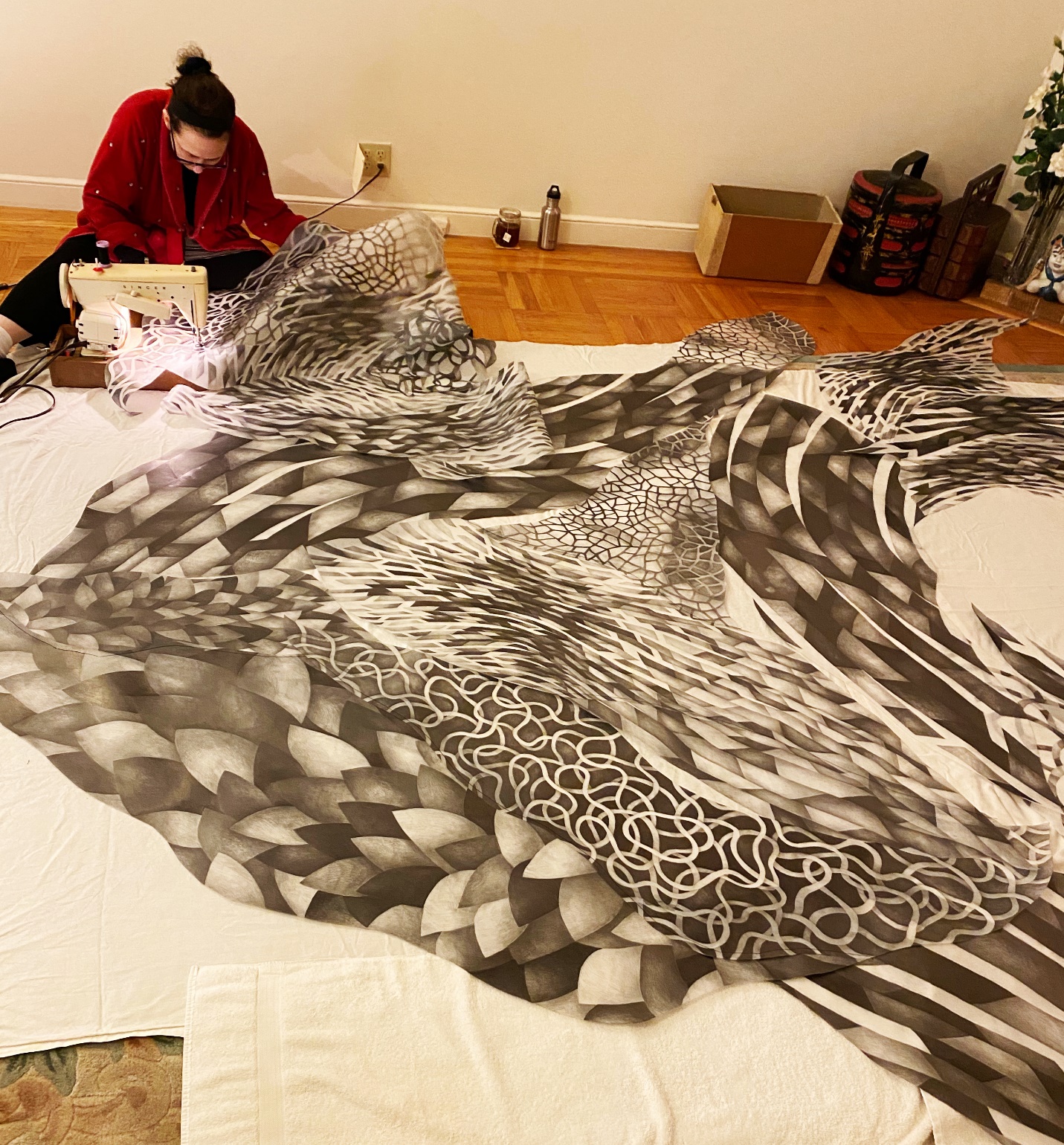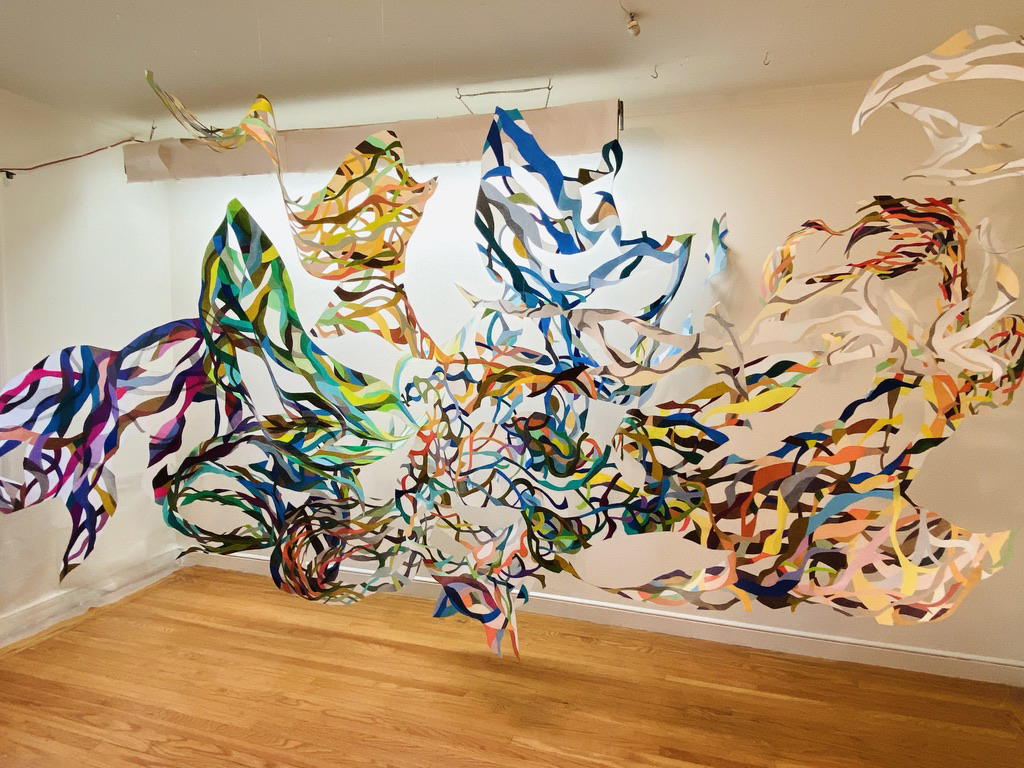In Dialogue with Holly Wong

Holly Wong working on “Phoenix.” Graphite on drafting film with sewing. 132 x 132 in. Photo courtesy of Al Wong
Phoenix, Holly Wong’s first solo show in the San Francisco Bay area is scheduled from April 1, 2021 through May 31, 2021 at SLATE in Oakland, features work she has created during the shelter in place order over the past year. These body of work reflects her spiritual and visual responses to the pandemic, and her sense of need for personal and social transformation through a wide variety of expressions, which include Phoenix, the large-scale drawing-based installation, other larger scale paintings on paper, a series of more intimate works on paper, and assemblages. Holly Wong says that as a response to her deep sense of loss and grief at the state of world affairs, she created a large mythical bird as a metaphor for her own body—”In Phoenix I see my desire for purification, cleansing and rebirth,” she says. When the artist thinks of the central theme of the show, she remembers excerpts from the Buddha’s Fire Sermon:
“The mind is burning, ideas are burning, mind-consciousness is burning, mind-contact is burning…” “Burning with what? Burning with the fire of lust, with the fire of hate, with the fire of delusion.”
Holly Wong shares with Art Spiel her thought and work processes and reflections on her overall body of work that has led her to this upcoming solo exhibition.
You focus on installation work based on assemblages and works on paper, involving both sewing techniques and painting. Tell me about your process and what brought you there.
When I was growing up, my mother often made my clothing as she had come from a family of German tailors; there was always a sewing machine in the house. I loved the softness of the fabric and often studied the patterns layering them with my hands to see the contrasts. At the same time, like many children, I had a passion to draw and it was drawing that let me to a pursuit of art making in terms of my college studies. Sewing and fibers arts in general were never separate and in my graduate studies, I began to work in larger scale installation art, eventually earning and MFA in New Genres, which for me was about being interdisciplinary. I love to draw, paint, sew and create environments and at the age of 49 now, I have finally come full circle to integrate all these things together. That integration echoes in many aspects of my personal life as I think the whole person is a composite of disparate elements that appear in conflict but really are in unison.

“Spiral Dance”. Colored pencil on drafting film with sewing suspended with monofilament wire. 108 x 150 in. Photo courtesy of the artist
Your work appears to be largely driven by material and drawing. How do you see the relationship between the two? And in that context I am curious to learn more about your journey from Flux II (2017), to Thought Traveler (2018), to your in progress, Phoenix (2020).
I have often said that my sewing line is a kind of drawing line or blood line. Sewing lines wander through fabric but you can often coax paper and many types of plastic through a sewing machine if one isn’t precious about it. Drawing and mark making in general is a release; an expression of identity and authentic self. “Flux II” involved both drawing with ink on drafting film, cutting it, and then sewing it onto the paper in fragments. “Thought Traveler” involved an obsessive sewing process of running the drafting film through the sewing machine hundreds of times to develop dark and gradated networks of lines and then cutting and reassembling into strips and sections. These two pieces reflected my thinking at the time that the sewing line was the dendrite, the nerve cell, and that it had its own form of consciousness. The large installation I am doing now titled “Phoenix” involves an extensive amount of drawing of patterns but also the assembly of these patterned sections with the sewing machine. If I reflect back, it shows my love of quilting fabric and my study of the way the squares create an interior world. At 132”H x 132”W, there is also a physicality to Phoenix and passing large swaths of it through a 1968 Singer sewing machine definitely makes me think of the physical, the body itself. It is very grounding.

Holly Wong sewing “Phoenix” on her 1968 Singer. Photo courtesy of Al Wong
Let’s keep looking at individual projects, for example, She. Feminist themes seem to play a central role in your work, from sewing to color and shape. Can you elaborate on this installation in that context?
She encompasses my desire to find the female identity before the creation of restricted gender roles, before religion, before the definition of “perfect” bodies and other restrictions on what and how women should act and behave. It is all about primordial energy and it welcomes wholeheartedly the expression of female identity in whatever way that people chose to identify. I think that point is an important one. In my early 40’s, I suffered from anorexia and learned on a very deep level that I had to completely redefine what I believed about my female body; the feminist and Goddess themes in my work emerged as a result and I do believe that they reveal themselves to me in my work in order to heal me. I believe I fully recovered in part because of their artistic intervention in my life.

“She” Colored pencil and graphite on drafting film, suspended with monofilament wire, 96 x 168 x 72 in. Photo courtesy of the artist
And I assume Juliet of the Spirits takes after Fellini’s film – what can you tell me about the genesis of this installation?
Yes, the Juliet of the Spirits series is an homage to Fellini’s 1965 masterpiece of Italian cinema. In this wonderful film, a repressed woman discovers her personal sense of liberation by exploring fantasy and the unconscious. In many ways, my artistic practice is a similar journey. These six works on paper explore the many facets of personal myth making and how that unleashes a deeper sense of freedom.
You mention in one of your studio tour videos the importance of the San Francisco light in your work. Can you elaborate on that in context of your installation Aurora?
My studio is in a back bedroom of my house and it faces West. We live about a mile away from the coast and so I have the privilege of viewing the intense California sunsets through my window each day. It bathes the room in a golden magical light which I think of as my “witching hour” as it were. Aurora was created in the winter months of 2020 when the light was colder, the days were shorter, and I was thinking of a kind of white, diffuse light that one often sees on foggy San Francisco days. These works are centered around that light and speak to an inner silence. The colors are more muted and layered, like the ways in which nature subtly emerges from the blanket of fog along the coastline here.

“Juliet of the Spirits 2,” Gouache, graphite and candle smoke on paper, with hand cut drafting film, 16 x 12 in. Photo courtesy of the artist
Your work resonates for me with joy, light, and music. What can you tell me about Silent Music in that context?
Silent Music is what I consider one of my breakthrough works. It was the first time I was able to work with color in a truly transparent way. I was sewing hundreds of squares of gift wrap film and dichroic film through a sewing machine to make these layered sheets and then piecing in arterial elements in them with darker patterned transparencies. So, the fiber art presence is there. But then I started suspending them and catching light with them and found a deep satisfaction in the way they made me think of spirit embodied. The piece is an homage to the Jazz classic Waltz for Debby by Bill Evans from 1962. He later did a duet with Tony Bennett in which Tony sings “she dances to silent music.” That line really spoke to me because it reflected that interior sense that there was something magical I could see and feel grow in myself; that I was beginning to dance and I was learning not to care if it was perfect or who saw me.

“Spiral Dance,” Dichroic film, vinyl tablecloth, plastic bags, gold foil, hand-painted vellum, and thread, 96 x 216 x 24 in. Photo courtesy of the artist
Mind Mountain has a more atmospheric sensibility – like a pastel drawing. What was your approach in this installation?
Mind Mountain was one of my earliest installations with fabric. I utilized white polyester tulle and then ran it through a sewing machine hundreds of times using light reflective thread. I then suspended it from the ceiling so that it caught the western light in an ephemeral an undefined way. I was thinking a lot about Zen Buddhism at this point and the notion that there is a space of formlessness. A space of mind/no mind. That our thoughts, our self, our history — none of it is fixed. The tulle is suspended and airy. It sometimes disappears depending on how it is lit, and I really like that.

“Mind/Mountain,” Polyester tulle and thread suspended with monofilament wire, 180 x 84 x 108 in. Photo courtesy of the artist
SLATE’s public open hours will vary depending on guidance from the County Health Department, so please check https://slateart.net/contact/ for updates, or email info@slateart.net to make an appointment for a private viewing.
Etty Yaniv works on her art, art writing and curatorial projects in Brooklyn. She founded Art Spiel as a platform for highlighting the work of contemporary artists, including art reviews, studio visits, interviews with artists, curators, and gallerists. For more details contact by Email: artspielblog@gmail.com